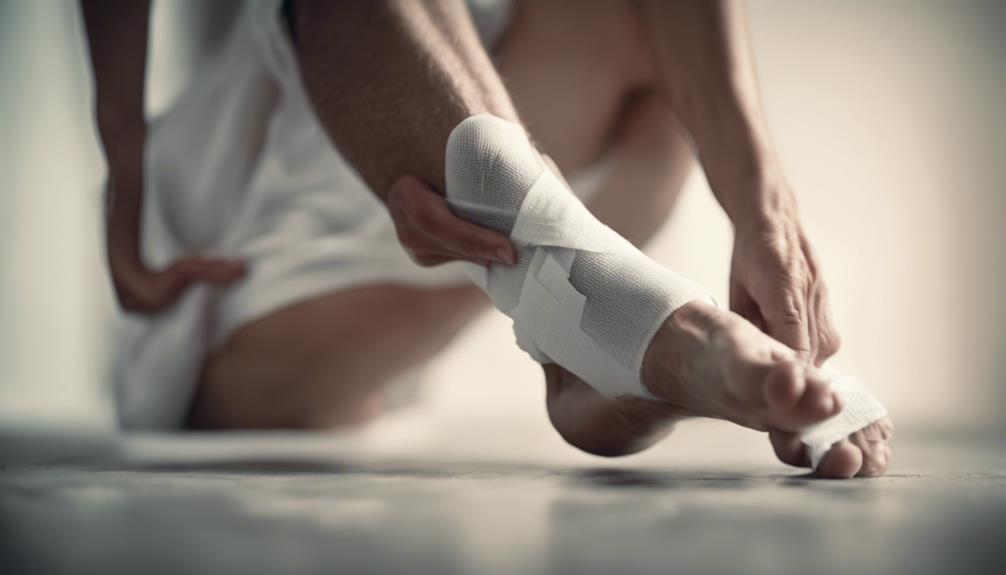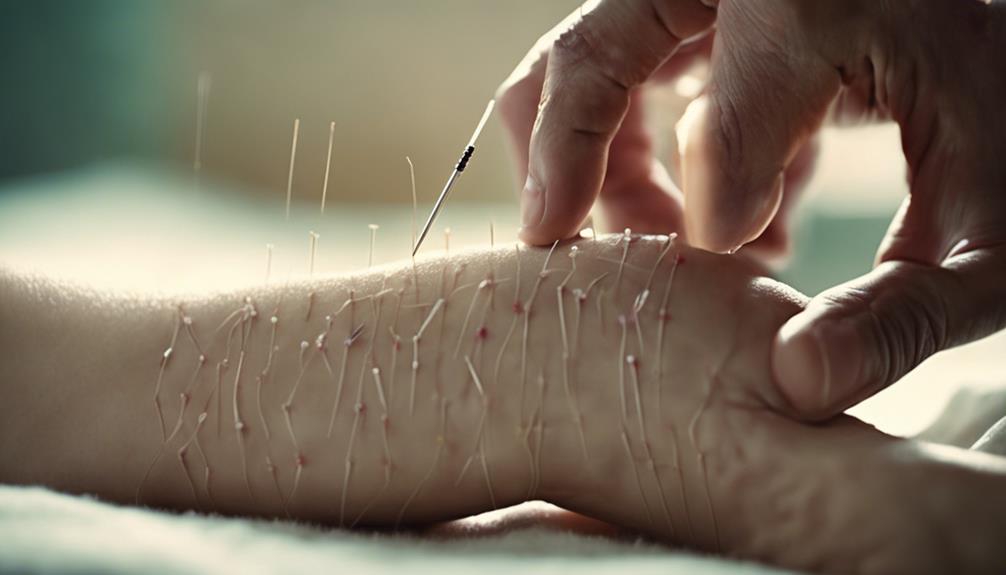When dealing with plantar fasciitis, natural remedies like the RICE method, stretching exercises, self-massage, acupuncture, proper footwear, chiropractic care, and holistic approaches can provide effective relief. Rest and ice reduce inflammation, while strengthening exercises and self-massage promote healing. Acupuncture targets pain and enhances recovery. Arch support in footwear and chiropractic adjustments aid in alignment and muscle strengthening. Holistic methods like essential oils and lifestyle changes complement treatments. These approaches offer a thorough heel healing strategy.
RICE Method for Inflammation Reduction

When dealing with plantar fasciitis, utilizing the RICE method can greatly aid in reducing inflammation and pain. Plantar fasciitis is a common condition characterized by inflammation of the plantar fascia, the tissue that connects the heel bone to the toes. This inflammation can lead to intense heel pain, especially with the first steps in the morning or after long periods of rest.
Rest is vital in allowing the damaged tissues to heal properly. By avoiding activities that aggravate the condition, the plantar fascia can begin to recover. Ice application is another essential component of the RICE method. The cold helps to constrict blood vessels, reducing inflammation and numbing the area, providing relief from pain.
Implementing the RICE method involves a cycle of Rest, Ice, Compression, and Elevation. While the focus here is on Rest and Ice, Compression through techniques like using a supportive bandage and Elevation by propping the foot up above heart level can further assist in reducing swelling and promoting healing.
Incorporating the RICE method into your daily routine can accelerate the recovery process of plantar fasciitis, bringing much-needed relief from the discomfort associated with this condition. It’s a simple yet effective way to manage inflammation and pain, allowing you to take proactive steps towards healing.
Strengthening Stretching Exercises
I find that incorporating targeted muscle stretches and resistance band exercises into my routine has been essential for improving my foot flexibility and strength.
These exercises have helped alleviate tension in my plantar fascia ligament and Achilles tendon, leading to reduced pain and enhanced healing.
Focusing on flexibility and strength through consistent practice has been instrumental in managing my plantar fasciitis symptoms effectively.
Targeted Muscle Stretches
Regularly incorporating targeted muscle stretches into your daily routine can greatly enhance flexibility and provide relief for plantar fasciitis symptoms. Foot stretches and calf stretches are particularly beneficial for strengthening the muscles involved in plantar fasciitis.
By reducing tension in the plantar fascia ligament and calf muscles, these exercises help alleviate heel pain and discomfort. The improved blood flow from these stretches promotes healing and prevents further injury. Strengthening these muscles also offers support to the arch of the foot, enhancing overall foot function and decreasing strain on the plantar fascia.
Including targeted muscle stretches in your daily regimen can complement other treatments and aid in the long-term management of plantar fasciitis symptoms.
Resistance Band Exercises
Incorporating resistance band exercises into your routine can effectively strengthen the muscles in your feet and calves, providing essential support for the plantar fascia and enhancing overall stability. These exercises not only help stretch the plantar fascia ligament, promoting flexibility, but also target specific muscle groups involved in plantar fasciitis.
Flexibility and Strength
Enhancing foot flexibility and strength through targeted stretching and strengthening exercises can effectively alleviate plantar fasciitis symptoms. Stretching exercises like towel stretches and wall stretches can enhance flexibility, while strengthening exercises such as calf raises and toe curls improve foot stability. Incorporating plantar fascia stretches like the plantar fascia stretch and heel cord stretch can prevent tightness. Strengthening the intrinsic foot muscles with exercises like marble pickups and arch lifts supports the arch and alleviates heel pain. Balance exercises like single-leg stands and heel-to-toe walks enhance foot strength and stability, reducing the risk of plantar fasciitis.
| Stretching Exercises | Strengthening Exercises |
|---|---|
| Towel Stretches | Calf Raises |
| Wall Stretches | Toe Curls |
| Plantar Fascia Stretches | Marble Pickups |
| Arch Lifts | |
| Balance Exercises |
Self-Massage Techniques for Recovery
To enhance recovery from plantar fasciitis, I recommend incorporating self-massage techniques targeting the heel and foot arch. Self-massage can be a powerful tool in relieving tension in the plantar fascia, the thick band of tissue that connects your heel to your toes and can become inflamed in cases of plantar fasciitis. By using your thumbs or a massage ball to apply pressure to specific areas on the sole of your foot for 10-15 minutes each day, you can stretch the plantar fascia and promote healing.
One effective self-massage technique is rolling your foot over a frozen water bottle. This not only massages the arch and heel but also provides the benefits of ice therapy, reducing inflammation and soothing pain. Regular self-massage not only helps to alleviate discomfort but also improves blood flow to the area, aiding in the healing process.
Acupuncture for Pain Relief

When it comes to acupuncture for pain relief in plantar fasciitis, understanding its effectiveness is key. The benefits of acupuncture therapy can be significant, especially for managing heel pain.
Let’s explore the process and experience of acupuncture to see how it can help alleviate plantar fasciitis symptoms.
Acupuncture Effectiveness Explained
Experiencing the immediate relief provided by acupuncture for plantar fasciitis is a remarkable proof of its effectiveness in reducing inflammation and promoting faster recovery. Acupuncture’s ability to target specific areas of discomfort, such as the feet in plantar fasciitis, can lead to accelerated healing and decreased pain. The localized effect of acupuncture on tissues plays a significant role in its success in treating inflammation associated with this condition.
Many individuals find relief after just one session, making it a promising natural treatment option for those seeking pain relief. Beyond reducing pain, acupuncture may offer additional benefits like improved circulation and relaxation, enhancing the overall healing process. Its innovative approach to addressing plantar fasciitis makes acupuncture a valuable tool in promoting recovery and well-being.
Benefits of Acupuncture Therapy
After witnessing the immediate relief provided by acupuncture for plantar fasciitis, it becomes evident that its benefits in reducing inflammation and promoting faster recovery are substantial.
Acupuncture therapy targets local tissues in the heel area, providing targeted heel pain relief and aiding in the healing process. The ability of acupuncture to reduce inflammation can be particularly beneficial for individuals suffering from plantar fasciitis, as this condition often involves inflammation of the plantar fascia.
Additionally, acupuncture’s effectiveness in alleviating pain and promoting healing makes it a valuable complementary treatment for plantar fasciitis relief. Some patients even report experiencing relief after just one acupuncture session, highlighting the rapid and impactful nature of this therapy in addressing heel pain.
Acupuncture Process and Experience
Acupuncture therapy utilizes thin needles inserted into specific points on the body to promote pain relief and healing, particularly effective for addressing plantar fasciitis.
During an acupuncture session for plantar fasciitis, the needles may target areas on the feet, legs, and other regions linked to pain modulation and inflammation reduction.
By stimulating the release of endorphins and enhancing circulation, acupuncture can help reduce inflammation and alleviate symptoms associated with plantar fasciitis.
Sessions typically last between 30 minutes to an hour, with the frequency of treatments depending on individual response and the condition’s severity.
Many patients experience decreased pain, improved mobility, and an overall sense of well-being following acupuncture for plantar fasciitis.
Proper Footwear With Arch Support

Wearing shoes with proper arch support is essential for alleviating discomfort and promoting foot health, especially for individuals with plantar fasciitis. The right footwear can make a significant difference in managing the symptoms of plantar fasciitis. Shoes with good arch support help distribute weight evenly across the foot, reducing pressure on the plantar fascia and minimizing strain on the heel.
When selecting shoes for plantar fasciitis, look for options specifically designed to provide adequate arch support. This support helps maintain the foot’s natural arch and prevents excessive pronation, which can exacerbate the condition. By improving foot alignment and cushioning the heel, shoes with proper arch support can aid in relieving pain associated with plantar fasciitis.
Additionally, good arch support in footwear offers stability and shock absorption, essential for individuals dealing with plantar fasciitis. The cushioning properties of these shoes help reduce the impact on the heel while walking or standing, promoting comfort and reducing discomfort.
Chiropractic Care Benefits
Chiropractic care offers effective relief for plantar fasciitis by utilizing specific adjustments and manipulations to alleviate pressure on the feet. When seeking chiropractic care for plantar fasciitis, individuals can benefit from a range of treatments and recommendations tailored to their specific needs.
Here are four ways chiropractic care can help alleviate plantar fasciitis symptoms:
- Foot Adjustments: Chiropractors can perform adjustments to the feet, ankles, and lower extremities to improve alignment and reduce stress on the plantar fascia, promoting healing and pain relief.
- Exercises: Chiropractors may recommend specific exercises to strengthen the muscles supporting the feet and ankles, helping to improve stability and reduce the risk of re-injury.
- Stretches: By incorporating targeted stretches into a daily routine, individuals can improve flexibility in the calves, hamstrings, and feet, which can alleviate tension on the plantar fascia and promote overall foot health.
- Holistic Treatments: In addition to adjustments, chiropractors may suggest holistic approaches such as nutritional guidance, lifestyle modifications, and other natural remedies to support overall wellness and enhance the body’s ability to heal.
Holistic Approaches to Healing

Exploring essential approaches to healing for plantar fasciitis involves integrating natural remedies, lifestyle adjustments, and alternative therapies to address the root causes of the condition and promote overall foot health.
When it comes to natural remedies, options like lavender essential oil, cabbage leaves, mustard oil, and aloe vera can offer anti-inflammatory and pain-relieving benefits. These remedies can be applied topically or ingested to help reduce inflammation and discomfort associated with plantar fasciitis.
Lifestyle modifications play an important role in holistic healing, with factors such as proper footwear, maintaining a healthy weight, and incorporating foot exercises into daily routines being vital for long-term relief.
Alternative therapies like acupuncture and chiropractic care provide non-invasive methods to alleviate symptoms and promote healing. Acupuncture targets specific points to improve energy flow and reduce pain, while chiropractic adjustments can help realign the body and relieve pressure on the plantar fascia.
Embracing essential healing approaches not only complements traditional treatments but also supports a comprehensive strategy for managing plantar fasciitis. By combining natural remedies, lifestyle adjustments, and alternative therapies, individuals can take a proactive stance in addressing the underlying causes of plantar fasciitis and nurturing overall foot health.
Conclusion
To sum up, when it comes to healing plantar fasciitis, there are plenty of natural remedies and treatments to explore. From the RICE method to acupuncture and chiropractic care, there are options for everyone.
Remember, Rome wasn’t built in a day, so be patient with your recovery. By incorporating these holistic approaches into your routine, you’ll be on the right track to finding relief and getting back on your feet in no time.

